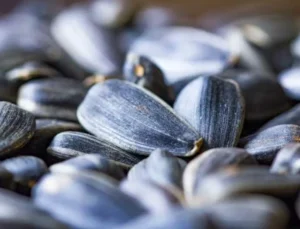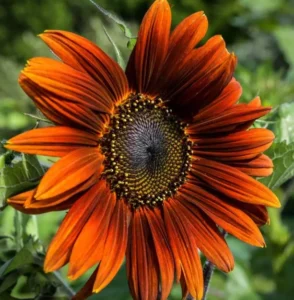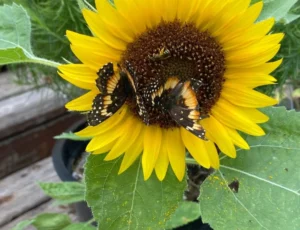 Sunflowers, scientifically known as Helianthus, belong to the daisy family Asteraceae and are native to North and Central America. The common sunflower (Helianthus annuus) is the most recognized species, celebrated for its large, bright yellow flower heads composed of hundreds or thousands of individual flowers. The outer petals, called ray florets, attract pollinators, while the inner disc florets develop seeds.
Sunflowers, scientifically known as Helianthus, belong to the daisy family Asteraceae and are native to North and Central America. The common sunflower (Helianthus annuus) is the most recognized species, celebrated for its large, bright yellow flower heads composed of hundreds or thousands of individual flowers. The outer petals, called ray florets, attract pollinators, while the inner disc florets develop seeds.
Sunflower seeds are edible, enjoyed raw or roasted, and are used to produce healthy sunflower oil, commonly used in cooking and salad dressings. Beyond their culinary value, sunflowers symbolize happiness, positivity, adoration, loyalty, and longevity in various cultures. Also, they exhibit heliotropism, following the sun from the east in the morning to the west by evening, maximizing sunlight exposure. They are adaptable to different climates and have deep root systems that support growth in various environments.
Historically, sunflower leaves have been used as fodder, flowers for yellow dye, and seeds for oil and food. Moreover, The oil also finds use in cooking, soap-making, and as a lubricant. Ecologically, sunflowers attract pollinators and aid in phytoremediation by absorbing toxic heavy metals from the soil.
Facts About Sunflowers
Symbol of Happiness
Sunflowers are often linked with happiness and positivity. Moreover, The bright yellow color of sunflowers catches the eye and brings a sense of joy to those who see them. Additionally, their radiant blooms have a captivating effect, instantly lifting the mood of anyone who beholds them.
Heliotropism
Sunflowers exhibit a fascinating behavior known as heliotropism, where the flower heads follow the movement of the sun across the sky. During the day, they face east in the morning and gradually turn westward by evening, maximizing their exposure to sunlight.
Tallest Sunflower
The tallest sunflower ever recorded reached an astonishing height of 30 feet and 1 inch (9.17 meters). In addition to this record-breaking plant was grown by Hans-Peter Schiffer in Germany in 2014. There, showcased the potential for extraordinary growth in these plants.
Edible Seeds

Sunflower seeds are not only tasty but also packed with nutrients. Moreover, they provide healthy fats, protein, fiber, and a variety of vitamins and minerals, making them a wholesome snack and a valuable addition to a balanced diet.
Multiple Flowers
A single sunflower head consists of hundreds or even thousands of individual flowers, with the bright outer petals known as ray florets and the smaller inner flowers called disc florets, where the seeds develop.
Bee-Friendly
Sunflowers are highly attractive to bees and other pollinators. However, their bright yellow color and plentiful nectar make them a favorite feeding spot for these essential insects, contributing to the health of ecosystems.
Sunflower Oil
People widely use sunflower seeds to produce sunflower oil, a popular cooking oil known for its mild flavor and high smoke point. Sunflower oil is also a common ingredient in beauty and skincare products due to its moisturizing properties.
Diverse Varieties

There are over 70 different species of sunflowers, each with unique characteristics. Furthermore, these varieties can differ in size, color, and petal arrangement, offering a wide range of options for gardeners and enthusiasts.
Cultural Significance
Sunflowers hold deep cultural significance in many societies. Furthermore, Some cultures associate sunflowers with adoration, loyalty, and longevity, while others link them to harvest and abundance, reflecting their versatility and importance.
Artistic Inspiration
Sunflowers have inspired countless artists, most notably Vincent van Gogh, whose series of sunflower paintings remain iconic. Additionally, Their vibrant colors and striking forms make them a compelling subject for various forms of art.
Historical Roots
Sunflowers have a long history and are native to North America. Also, Native Americans cultivated sunflowers for their seeds, oil, and medicinal properties, highlighting the plant’s historical and cultural significance.
Sunflower Head Size
The size of a sunflower head can vary greatly depending on the variety. Some sunflower heads can reach diameters of up to 12 inches (30 centimeters) or more, making them an impressive sight in any garden.
Read Also
Fun Facts About Weed | Roll And Learn With Cannabis
Funny Plant Facts | Surprising and Amusing Botanical Tales
Soccer Fascinating Facts: Discover The World of Goals
Sunflower Seeds in Space
In 2012, U.S. astronaut Don Pettit brought sunflower seeds to the International Space Station. Also, He documented their growth in the unique conditions of microgravity, providing valuable insights into plant biology and growth in space.
Ukraine: Largest Producer
Ukraine is the world’s largest producer of sunflower seeds. Furthermore, In 2018, Ukraine produced over 15 million tons of sunflower seeds, according to FAOSTAT, highlighting its crucial role in global sunflower agriculture.
Versatile Uses
Beyond their beauty, sunflowers have a variety of uses. Additionally, They can be processed into cooking oil, bird feed, and livestock feed, and even used as a natural dye for fabrics, showcasing their versatility and utility.
Conclusion
Lastly, sunflowers (Helianthus) are remarkable plants known for their vibrant appearance, practical applications, and cultural significance. Moreover, Their bright yellow flower heads, heliotropic behavior, and adaptability make them a beloved symbol of happiness and positivity. Sunflower seeds and oil offer nutritional benefits, while the plants themselves contribute to ecological health and soil remediation. Throughout history and across cultures, sunflowers have brought joy and utility, solidifying their place as one of the world’s most cherished flowers.
FAQ’s
What are sunflowers a symbol of?
Sunflowers are a symbol of happiness, positivity, and strength. Sunflowers represent harvest, bounty, and provision, and people often use them to symbolize a bright future and a close bond between friends and loved ones. Additionally, many people see sunflowers as a sign of hope, warmth, and lasting happiness, and believe that they bring joy and positivity into their lives. Moreover, Various cultures revere sunflowers for their beauty, resilience, and cheerful nature. However, viewing them as symbols of enlightenment, spiritual awakening, and personal growth.











